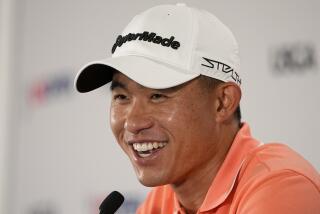After 51 Years on Tour, Snead Takes It Easy
- Share via
HOT SPRINGS, Va. — Don’t expect to see Sam Snead at the U.S. Senior Open this weekend. He’ll be busy picking berries.
Or maybe he’ll be feeding the turkeys near his home in this resort community amid the George Washington National Forest.
It’s also possible Snead may play a leisurely round of golf on one of The Homestead’s three courses, where he acquired the skills that brought him more victories (84) than any player in PGA Tour history.
But at age 77, Snead no longer feels the urge to tee it up week after week against top-flight competition.
“I thought I’d just give it a rest for a while,” Snead said. “I just got tired of playing and I lost so much desire.
“I’m all right once I get started, but geez, before I get started, it’s like, ‘What am I doing here?’ I just can’t seem to get excited about it like I used to.”
Snead stopped playing regularly on the PGA Seniors Tour two years ago, and it has been a decade since he was a member of the regular tour.
“I thought 51 years of that was pretty much enough,” he said. “Now I’m doing some of the things I never took time to do.”
Snead joined the tour in 1937 at age 25, marking the occasion by finishing second in the U.S. Open.
He was the tour’s leading money winner the following year, a feat he achieved twice more, including 1950, when he won 10 tournaments and finished with $35,758 in winnings.
Snead, who also won 13 Seniors events, is credited by independent record-keepers with 135 tournament victories, but not all are recognized by the PGA. As it is, his 84 victories on the PGA Tour is 13 more than Jack Nicklaus, 22 ahead of Ben Hogan and 23 better than Arnold Palmer.
His accomplishments have been measured in other ways as well. While playing in a regular tour event in 1979, the 67-year-old Snead shot his age, then came back the next day with a 66.
He still has the smooth, almost effortless swing that is his trademark, as well as the straw fedora that makes him so easy to spot on a golf course.
“I’m not playing too badly. I guess for a man 100 years old, it’s not too bad,” he deadpanned.
“To tell you the truth, I don’t miss it at all right now. I watch it in the papers and on TV.
“Well, I do miss seeing the guys. You usually have a clique, more or less, and I got to know a good group of guys.”
One thing Snead doesn’t miss is playing for prizes that were paltry compared with today’s million-dollar purses.
“I was too old when the good money came along,” said Snead, whose career winnings total only $726,700.
“We played many tournaments with just a $5,000 purse,” Snead said. One such tournament was the 1946 British Open, which he won.
“That British Open was worth $600 to me,” he said. “And it cost me $2,000 to go play in it.”
Money isn’t the only thing that has changed in golf since Snead’s heyday.
“Coming out of high school, I played in three tournaments,” he said. “That was my amateur career -- the whole deal.
“But look at these kids now. They have the best of equipment, the best of playing conditions, the best tournaments and everything like that.”
Such improvements, he said, have created an atmosphere in which “anybody half decent comes along now, he can be a millionaire in three years.”
Snead is hardly crying poverty. He has taken advantage of the increasing popularity in recent years of the corporate outing, and companies pay him handsome fees to spend time on the golf course with clients and employees.
“Last year, I did about 20 or 25, and this year I’ll probably do about 16,” said Snead, just returned from one such outing in Finland.
Snead also represents The Homestead, the lavish resort on which the Hot Springs economy thrives. And he has signed to represent Meadowwood, a new golf resort in Fort Pierce, Fla., where Snead plans to spend the winter months.
Then there’s Sam Snead’s Tavern in downtown Hot Springs, a busy pub with walls covered by hundreds of magazine covers documenting Snead’s golfing feats and photographs from his big-game hunting expeditions.
Snead said his appetite for hunting has been satisfied.
“Now, for some reason, I’d just as soon make a pet out of them,” he said.
The magazine covers chronicle his major victories -- three each in the Masters and the PGA -- and his selections to the PGA and World Golf halls of fame.
They do not point out what some consider the lone blemish on Snead’s professional resume: his failure to win the U.S. Open, a tournament in which he finished second on four occasions.
“I think about it every now and then. I got a couple of bad calls, but I won’t go into them,” he said.
“You have to have the breaks, there’s no question. But a guy playing well is going to get more breaks.”
If Snead ever does come back, he knows it will be difficult.
“I don’t practice anymore, and if I start back, I’d have to go in for a couple weeks of hard practice -- at the very least. You need to have your game sharp, otherwise you’re wasting your time,” he said.
“But I’ll tell you, if I get the feeling, it’s like an old horse. When the bell rings, it wants to go.”
More to Read
Go beyond the scoreboard
Get the latest on L.A.'s teams in the daily Sports Report newsletter.
You may occasionally receive promotional content from the Los Angeles Times.









